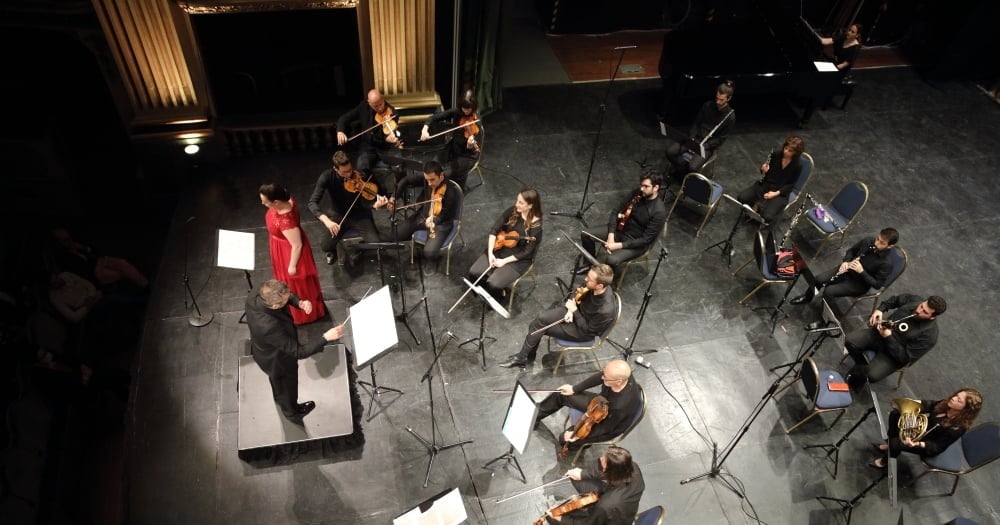
Teatru Manoel and Malta Spring Festival
Novarte Concert Review
Ateş Orga
4/27/20224 min read


Guest Reviewer, Ateş Orga
“Musicologists may analyse scores and come up with their conclusions – and they may be perfectly right – but their findings need not indicate anything conscious on my part”. Thus Iannis Xenakis, the centenary of whose birth has permeated much of this year’s intricately planned Malta Spring Festival. Xenakis – who first came my way decades ago in the unlikely guise of Aaron Copland conducting Pithoprakta with the LSO (for which I was tasked with writing the programme notes), latterly through Yuji Takahashi negotiating the near impossibilities of Eonta for piano and brass (“there are physical limits to the capacity of lips” in Boulez’s famous phrase) – has never been for the faint hearted, either as a performing or listening experience. His laws of seeding, organisation, rhythm, ensemble and intonation are no one else’s, elemental origins leading to elemental forces to elemental consequences. The Festival’s opening concert (KorMalta, St Paul’s Anglican Cathedral, 19 April) demonstrated though that not all his computations were necessarily deep space journeys. À Hélène (1977) sets lines from Euripides’s romantic drama Helen, produced in Athens at the Dionysia of 412 BC. In the eyes of the old tragedian Helen of Troy, the most beautiful woman in the world, fairer even than the gods, her image in Troy but her person in Egypt, lives by compassion, virtue and oaths. “Two [treble] parts (choruses) strictly equal … No strong or weak beats … Articulate well, emphasising the consonants … Rough, uncultured voices.” Riccardo Bianchi, who in a short time has developed the Maltese Islands’ national choir, a still young body, into an organically balanced ensemble leavened with characterful solo voices, secured a cohesive, linguistically nuanced reading in the context of a ‘Mediterranean’ programme ranging from Pizzetti to Clausetti but regretful for omitting Véronique Vella’s originally advertised Il-Kebbies tal-Fanali (The Lantern Lighter). Given the resonance of Valletta’s Anglican Cathedral, discrete amplification might have benefitted Evan Plumpton’s recessed guitar in Castelnuovo-Tedesco’s tricky Romancero Gitano.Two years earlier than À Hélène, Phlegra for eleven instruments (closing concert, Novarte Ensemble, Teatru Manoel, April 23) contrasts starkly. In 4/4 at an unchanging crotchet=48, without perceived accented downbeats, resonating spheres of advanced playing techniques and strings without vibrato, the title refers to the Macedonian/Balkan peninsula, the volcanic “place of burning” where in Greek mythology the Gigantes, Strabo’s “impious, lawless” creatures of great size and strength, were overthrown by the Olympian gods. Xenakis’s primal, alien, spatial sounds, simian clamberings, furtive scurryings and ancient calls, each fff and ppp proportionate to instrument and context – subjectively less a battlefield, more the distant songs and blooms, the wing-footed winds of before and after – strangely conjure a landscape all but seen/sensed through reversed lenses.In serioso mood, Dimitri Scarlato, these days Professor in Composition for Screen at the RCM, nursed his Greek players from Athens with care, rightly feeling that negotiating the traps and lava fields of this music needs primarily a clear beat to assure coherence and communication. Likewise with Sofia Gubaidulina’s Concordanza (1971), just about homing in on that “consonance in the midst of a world of sound filled with dissonance” which she desired to find. A tough, intransigent, (of its Soviet day) politically radical statement. In the premiere of his own Lumière à la tombée de la nuit, commissioned by the Festival, he took more risks, especially in the unfolding of the progressively lyrical second half – pages of particular expressive beauty. Inspired by the Festival’s global theme, About Hope, “this piece,” he writes, “aims to portray an imaginary journey, full of obstacles, that eventually leads to a hopeful outcome. The light (lumière) is the symbolical internal compass that we need to get through difficult moments in our life. The composition of the work was in part influenced by developments in Ukraine during February and March 2022, and tries to depict the sorrow and uncertainty of this history-changing moment, leaving still space for light at the end of the night.”With a title drawn from Psalm 42, Karl Fiorini’s latest venture, In the Roar of your Torrents, is an ‘expression-poem’ broadly triartite in form (nine minutes thereabouts). Commenting in the programme book, the writer and philosopher Aleks Farrugia notes “the ‘downcast soul’ in search for a beacon of Hope. Yet equally it can be about the ‘downcast soul’ of a whole Nation at war for survival as much as an intimate lament about the woes of the Self. Following the Psalm, the music from the outset bares a lingering pain that builds inexorably until long wailing notes reach desperation with occasional outbursts from the strings sounding like screams rising from accumulated stress. Tensions/torrents, in the plural. Growing/consuming, from different directions. A trumpet rings the alarm, tensions escalate, becoming one sustained voice of long, agonised notes. A string of long drawn sighs. Then a defiant trumpet solo in the middle announces impending conflict. Parallel rhythms, breaking music, new tensions, energy, the struggle takes over. Beneath, the tension continues to brew, there is darkness, danger. Yet it’s countered by vigorousness, motion, perhaps even a playful cheekiness, ever defiant. Come the end we part ways with the Psalmist: there is no hope in an ever-loving God. The strife of the previous struggle drops to a single long-drawn note. A new voice: the tension has been loosened, the threat suspended. But it is a non-ending, a cadence without resolution. There is no peace here, no catharsis. Just waiting.” Distinctive Fiorini fingerprints, sonic and structural, are to be found. To those who know the conclusions of his First Piano Sonata [http://www.colinscolumn.com/charlene-farrugia-at-the-malta-spring-festival-khachaturians-recitatives-fugues-music-by-xenakis-and-george-crumb-and-karl-fiorinis-first-piano-sonata/?fbclid=IwAR1XaL7EO5ixgN9qzXipFvW1lQJV7Uy5x2mSkJUpgqr5C7gzX1874EmrPaE] or In the Midst of Things [Grand Piano GP880], the repetitive closing patterns and energy of the final con fuoco section will be familiar. The lean scoring, the harmonic aggregations, the contrasts of nervosity and stasis, the ability to soften without cancelling dissonance (the two held swelling/dying grave chords cadencing off the piece for example) make for a recognizably personal canvas. Flute/piccolo, oboe, clarinet, bassoon, horn, trumpet, trombone, xylophone, snare drum, piano, violin I x 4, violin II x 3, viola x 2, cello x 2, double bass (strings variably divisi). Under the watchful eye of Scarlato, the Novarte Ensemble, led by Florenc Zisimos Sulkuqi, made a brave showing.“Along with Strauss, Sibelius and Schoenberg,” avowed Bernstein, “Mahler sang the last rueful songs of 19th century romanticism,” his destiny “to sum up, package, and lay to ultimate rest the fantastic treasure that was German-Austrian music from Bach to Wagner”. Sincere, refreshingly free of diva attitude, an imposing presence in imperious red, the farewell star of the Festival, the Finnish mezzo Niina Keitel, brought dark-coloured vocals and tearfully expansive fin de siècle emotions to Mahler’s Rückert-Lieder in Daniel Grossmann’s 2009 chamber version – an arrangement at times thin on the ground, calling for more body, but at best suggestive of richer intentions.
Subscribe
Don't miss out on exclusive news, upcoming concert premieres, live streams and other benefits by subscribing to our newsletter.


